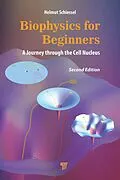Biophysics is a new way of looking at living matter. It uses quantitative experimental, theoretical, and computational methods, thereby opening a new window for studying and understanding life processes. This textbook provides a brief introduction to the basics of the field, followed by in-depth discussions of more advanced biophysics subjects, going all the way to state-of-the-art experiments and their theoretical interpretations. The second edition presents some of the newest developments in the field (e.g., biomolecular condensates, loop extrusion), a new chapter on computational methods, and many computer exercises specially designed for this textbook.
Autorentext
Helmut Schiessel studied physics at the Albert-Ludwigs University, Freiburg, Germany. There he did his PhD with Prof. A. Blumen in the Group for Theoretical Polymer Physics. After graduating in 1997, he worked as a postdoc with Prof. P. A. Pincus at the University of California, Santa Barbara. Then, he was a joint postdoc with Profs. W. M. Gelbart and R. Bruinsma at the University of California, Los Angeles. In 2000 he joined the Theory Group of the Max Planck Institute for Polymer Research, Mainz, Germany, where he was in charge of a biophysics research project. From 2005 to 2020, Prof. Schiessel headed the chair of Theoretical Physics of Life Processes in the Instituut-Lorentz at Leiden University, the Netherlands. In 2021, he joined the Cluster of Excellence Physics of Life at the Technical University in Dresden, Germany, where he heads the Theoretical Physics of Living Matter group.
Inhalt
Biophysics for Beginners
